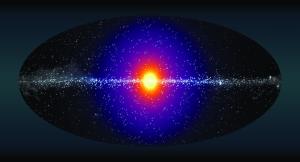Blog
Annihilating a Theory
22 September 2020
 Christopher Dessert, Nicholas L. Rodd, Benjamin R. Safdi, Zosia Rostomian (Berkeley Lab)
Christopher Dessert, Nicholas L. Rodd, Benjamin R. Safdi, Zosia Rostomian (Berkeley Lab)There are times when it feels like dark matter is just toying with us. Just as we gather evidence that hints at one of its properties, new evidence suggests otherwise. So it is with a recent work looking at how dark matter might behave in the center of our galaxy.1
It all comes down to the fact that dark matter must be studied indirectly, since it doesn’t interact strongly with light, and we haven’t directly detected any dark matter particles. By analyzing how galaxies cluster and how dark matter interacts with light gravitationally, we know that dark matter is cold and is mostly found where galaxies come together. But beyond that, things get more unclear.
You might remember last week I wrote about a computer simulation of dark matter that showed that dark matter tends to clump into dense haloes around galaxies and galactic clusters. Another recent study found that dark matter even clumps tightly around galaxies within superclusters. Both of these suggest that dark matter might interact with itself in a way that produces cold pockets of the stuff.
 Oscar Macias
Oscar MaciasThis is exciting because it connects to other studies that found unexplained gamma rays coming from the center of our galaxy. If dark matter does self-interact, it could emit gamma rays such as those we’ve observed. The energy lost by dark matter in the form of gamma rays could also explain the cold clumping we see in galactic superclusters. It’s all finally coming together, right?
Well, not so fast. This latest work looked at the distribution and spectrum of the gamma rays coming from the Milky Way and compared it to the gamma rays produced by known astrophysical processes. It found that dark matter isn’t needed to explain the gamma rays. Even if you tweak things to be incredibly generous toward dark matter, it still isn’t required. What looked like a possible breakthrough now looks less promising.
It is still possible that dark matter interacts and emits gamma rays, but at this point, there is no evidence to confirm the idea. So we’re back to more questions than answers when it comes to dark matter.
Although this is disappointing, there is reason to be hopeful. We are now at the point of gathering a great deal of data about dark matter. We’ve moved beyond the era of knowing almost nothing about it, which means that in time we should be able to solve the dark matter mystery.
Abazajian, Kevork N., et al. “Strong constraints on thermal relic dark matter from Fermi-LAT observations of the Galactic Center.” Physical Review D 102.4 (2020): 043012. ↩︎